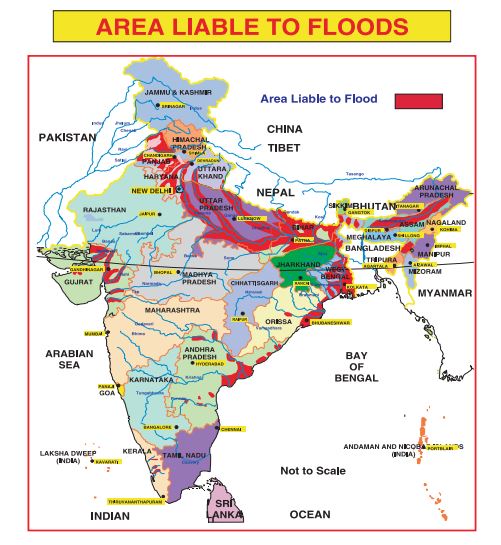Geography
Flood Plain Zoning
- 13 Nov 2021
- 6 min read
Why in News
Recently, a Comptroller and Auditor General of India (CAG) report on preparedness and response to floods was presented in the Kerala assembly.
- The report was prepared against the backdrop of the devastating Kerala floods of 2018.
- The report pointed out that the state is yet to enact flood plain zoning legislation, 45 years after the Union Government circulated to all states a model draft bill for flood plain zoning legislation.
Key Points
- About:
- Concept: The basic concept of flood plain zoning is to regulate land use in the flood plains to restrict the damage caused by floods.
- Determining Developmental Activities: It aims at determining the locations and the extent of areas for developmental activities in such a fashion that the damage is reduced to a minimum.
- Adds Limitations: It envisages laying down limitations on development of both the unprotected as well as protected areas.
- In the unprotected areas, boundaries of areas in which developmental activities will be banned, are to be established to prevent indiscriminate growth.
- In the protected areas, only such developmental activities can be allowed, which will not involve heavy damage in case the protective measures fail.
- Utility: Zoning cannot remedy existing situations, although, it will definitely help in minimising flood damage in new developments.
- Flood plain zoning is not only necessary in the case of floods by rivers but it is also useful in reducing the damage caused by drainage congestion particularly in urban areas.
- Vulnerability to Floods:
- India’s high risk and vulnerability is highlighted by the fact that 40 million hectares out of a geographical area of 3290 lakh hectares is prone to floods.
- On an average every year, 75 lakh hectares of land is affected, 1600 lives are lost and the damage caused to crops, houses and public utilities is Rs. 1805 crores due to floods.
- Model Bill for Flood Plain Zoning:
- About: The Bill provides clauses about flood zoning authorities, surveys and delineation of flood plain area, notification of limits of flood plains, prohibition of the use of the flood plains, compensation and most importantly removing obstructions to ensure free flow of water.
- It will seek to replace dwellings in low-lying areas by parks and playgrounds as absence of human settlement in those areas would cut down loss of lives and property.
- Challenges in Implementation:
- There has been resistance on the part of the states to follow-up the various aspects of floodplain management including possible legislation.
- The reluctance of the states is mainly due to population pressure and want of alternative livelihood systems.
- The lukewarm response of the states towards the enactment and enforcement of the floodplain regulations has fuelled a significant increase in the encroachments into the flood plains, sometimes authorised and duly approved by the town planning authorities.
- There has been resistance on the part of the states to follow-up the various aspects of floodplain management including possible legislation.
- About: The Bill provides clauses about flood zoning authorities, surveys and delineation of flood plain area, notification of limits of flood plains, prohibition of the use of the flood plains, compensation and most importantly removing obstructions to ensure free flow of water.
- Related Constitutional Provisions and Other Measures:
- Based on the inclusion of drainage and embankments as entry 17 of List II (State List), flood control has been seen to fall under the purview of the state government, except in the case of “regulation and development of inter-state rivers and river valleys,” which is mentioned in entry 56 of List I (Union List).
- Floodplain zoning is firmly within the state government’s ambit as it deals with the land along the riverbanks and land is a state subject under entry 18 of List II.
- The central government’s role can only be to issue advisories and prescribe guidelines.
- Flood control and mitigation are not directly mentioned in any of the three legislative lists included in the seventh schedule Constitution.
- The National Disaster Management Authority (NDMA) in 2008 has issued guidelines for states for floodplain zoning as an important “non-structural measure” to mitigate floods.
- It suggested that areas likely to be affected by floods in a frequency of 10 years should be reserved for green areas like parks, gardens and others while concrete structures should not be allowed there.
- It also talked about other zones in the floodplain like in areas of flooding in a 25-year frequency and asked states to make plans accordingly in those areas.
- Based on the inclusion of drainage and embankments as entry 17 of List II (State List), flood control has been seen to fall under the purview of the state government, except in the case of “regulation and development of inter-state rivers and river valleys,” which is mentioned in entry 56 of List I (Union List).
Way Forward
- As floods cause major damage to life and property every year, it is time the central and the state governments prepare a long-term plan that goes beyond piecemeal measures like building embankments and dredging to control floods.
- There is a need for an integrated basin management plan that brings all the river-basin sharing countries as well Indian states on board.





